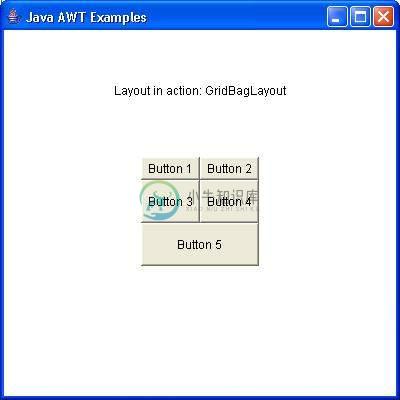GridBagLayout
介绍 (Introduction)
GridBagLayout类以水平和垂直方式排列组件。
类声明
以下是java.awt.GridBagLayout类的声明:
public class GridBagLayout
extends Object
implements LayoutManager2, Serializable
字段 (Field)
以下是java.awt.BorderLayout类的字段:
double[] columnWeights - 此字段包含列权重的覆盖。
int[] columnWidths - 此字段包含列最小宽度的覆盖。
protected Hashtable comptable - 此哈希表维护组件与其gridbag约束之间的关联。
protected GridBagConstraints defaultConstraints - 此字段包含一个包含默认值的gridbag约束实例,因此如果某个组件没有与之关联的gridbag约束,则将为该组件分配defaultConstraints的副本。
protected java.awt.GridBagLayoutInfo layoutInfo - 此字段包含protected java.awt.GridBagLayoutInfo layoutInfo的布局信息。
protected static int MAXGRIDSIZE - 网格包布局可以布置的最大网格位置数(水平和垂直)。
protected static int MINSIZE - 网格包布局可以布局的最小网格。
protected static int PREFERREDSIZE - 网格包布局可以布局的首选网格大小。
int[] rowHeights - 此字段包含行最小高度的覆盖。
double[] rowWeights - 此字段包含行权重的覆盖。
类构造函数
| SN | 构造函数和描述 |
|---|---|
| 1 | GridBagLayout() 创建网格包布局管理器。 |
类方法
| SN | 方法和描述 |
|---|---|
| 1 | void addLayoutComponent(Component comp, Object constraints) 使用指定的约束对象将指定的组件添加到布局中。 |
| 2 | void addLayoutComponent(String name, Component comp) 将具有指定名称的指定组件添加到布局中。 |
| 3 | protected void adjustForGravity(GridBagConstraints constraints, Rectangle r) 根据约束几何体和打击垫,将x,y,width和height字段调整为正确的值。 |
| 4 | protected void AdjustForGravity(GridBagConstraints constraints, Rectangle r) 此方法已过时,仅提供向后兼容性; 新代码应该调用adjustForGravity。 |
| 5 | protected void arrangeGrid(Container parent) 布置网格。 |
| 6 | protected void ArrangeGrid(Container parent) 此方法已过时,仅提供向后兼容性; 新代码应该调用arrangeGrid。 |
| 7 | GridBagConstraints getConstraints(Component comp) 获取指定组件的约束。 |
| 8 | float getLayoutAlignmentX(Container parent) 返回沿x轴的对齐方式。 |
| 9 | float getLayoutAlignmentY(Container parent) 返回沿y轴的对齐方式。 |
| 10 | int[][] getLayoutDimensions() 确定布局网格的列宽和行高。 |
| 11 | protected java.awt.GridBagLayoutInfo getLayoutInfo(Container parent, int sizeflag) 为当前托管子集填充GridBagLayoutInfo实例。 |
| 12 | protected java.awt.GridBagLayoutInfo GetLayoutInfo(Container parent, int sizeflag) 此方法已过时,仅提供向后兼容性; 新代码应该调用getLayoutInfo。 |
| 13 | Point getLayoutOrigin() 在目标容器的图形坐标空间中确定布局区域的原点。 |
| 14 | double[][] getLayoutWeights() 确定布局网格的列和行的权重。 |
| 15 | protected Dimension getMinSize(Container parent, java.awt.GridBagLayoutInfo info) 根据getLayoutInfo()中的信息计算出master的最小大小。 |
| 16 | protected Dimension GetMinSize(Container parent, java.awt.GridBagLayoutInfo info) 此方法已过时,仅提供向后兼容性; 新代码应该调用getMinSize。 |
| 17 | void invalidateLayout(Container target) 使布局无效,表明如果布局管理器缓存了信息,则应将其丢弃。 |
| 18 | void layoutContainer(Container parent) 使用此网格包布局布置指定的容器。 |
| 19 | Point location(int x, int y) 确定布局网格中的哪个单元格包含(x,y)指定的点。 |
| 20 | protected GridBagConstraints lookupConstraints(Component comp) 检索指定组件的约束。 |
| 21 | Dimension maximumLayoutSize(Container target) 给定指定目标容器中的组件,返回此布局的最大尺寸。 |
| 22 | Dimension minimumLayoutSize(Container parent) 使用此网格包布局确定父容器的最小大小。 |
| 23 | Dimension preferredLayoutSize(Container parent) 使用此网格包布局确定父容器的首选大小。 |
| 24 | void removeLayoutComponent(Component comp) 从此布局中删除指定的组件。 |
| 25 | void setConstraints(Component comp, GridBagConstraints constraints) 在此布局中设置指定组件的约束。 |
| 26 | String toString() 返回此网格包布局值的字符串表示形式。 |
方法继承
该类继承以下类中的方法:
java.lang.Object
GridBagLayout示例
使用您选择的任何编辑器创建以下java程序,例如D:/ 》 AWT 》 com 》 iowiki 》 gui 》
AwtLayoutDemo.javapackage com.iowiki.gui;
import java.awt.*;
import java.awt.event.*;
public class AwtLayoutDemo {
private Frame mainFrame;
private Label headerLabel;
private Label statusLabel;
private Panel controlPanel;
private Label msglabel;
public AwtLayoutDemo(){
prepareGUI();
}
public static void main(String[] args){
AwtLayoutDemo awtLayoutDemo = new AwtLayoutDemo();
awtLayoutDemo.showGridBagLayoutDemo();
}
private void prepareGUI(){
mainFrame = new Frame("Java AWT Examples");
mainFrame.setSize(400,400);
mainFrame.setLayout(new GridLayout(3, 1));
mainFrame.addWindowListener(new WindowAdapter() {
public void windowClosing(WindowEvent windowEvent){
System.exit(0);
}
});
headerLabel = new Label();
headerLabel.setAlignment(Label.CENTER);
statusLabel = new Label();
statusLabel.setAlignment(Label.CENTER);
statusLabel.setSize(350,100);
msglabel = new Label();
msglabel.setAlignment(Label.CENTER);
msglabel.setText("Welcome to IoWiki AWT Tutorial.");
controlPanel = new Panel();
controlPanel.setLayout(new FlowLayout());
mainFrame.add(headerLabel);
mainFrame.add(controlPanel);
mainFrame.add(statusLabel);
mainFrame.setVisible(true);
}
private void showGridBagLayoutDemo(){
headerLabel.setText("Layout in action: GridBagLayout");
Panel panel = new Panel();
panel.setBackground(Color.darkGray);
panel.setSize(300,300);
GridBagLayout layout = new GridBagLayout();
panel.setLayout(layout);
GridBagConstraints gbc = new GridBagConstraints();
gbc.fill = GridBagConstraints.HORIZONTAL;
gbc.gridx = 0;
gbc.gridy = 0;
panel.add(new Button("Button 1"),gbc);
gbc.gridx = 1;
gbc.gridy = 0;
panel.add(new Button("Button 2"),gbc);
gbc.fill = GridBagConstraints.HORIZONTAL;
gbc.ipady = 20;
gbc.gridx = 0;
gbc.gridy = 1;
panel.add(new Button("Button 3"),gbc);
gbc.gridx = 1;
gbc.gridy = 1;
panel.add(new Button("Button 4"),gbc);
gbc.gridx = 0;
gbc.gridy = 2;
gbc.fill = GridBagConstraints.HORIZONTAL;
gbc.gridwidth = 2;
panel.add(new Button("Button 5"),gbc);
controlPanel.add(panel);
mainFrame.setVisible(true);
}
}
使用命令提示符编译程序。 转到D:/ 》 AWT并键入以下命令。
D:\AWT>javac com\iowiki\gui\AwtlayoutDemo.java
如果没有错误,那意味着编译成功。 使用以下命令运行程序。
D:\AWT>java com.iowiki.gui.AwtlayoutDemo
验证以下输出


